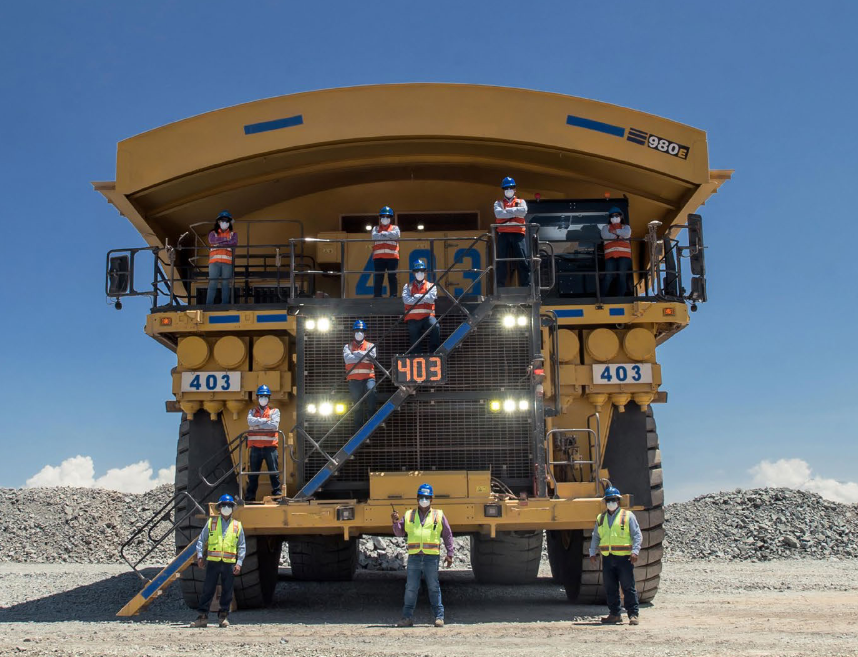Global copper, gold and moly miner Freeport McMoRan has just published an updated version of its Climate Change report for 2021, in which it firmly outlines its commitment to an electric future for its mining fleets. Entitled “Electrifying the future” in the opening statement, Richard C. Adkerson Chairman of the Board and Chief Executive Officer says that Freeport “is advancing important initiatives to reduce our greenhouse gas (GHG) emissions, improve energy efficiency, evaluate and integrate the use of lower carbon and renewable energy and enhance our resilience to future climate-related risks.”
Freeport now has four 2030 GHG emissions (Scope 1 and 2) reduction targets, which help it to manage relevant, climate-related risks and support the decarbonisation of our business globally. The first target, established in 2020, seeks to reduce the GHG emissions intensity of its Americas copper operations by 15% by 2030 from its 2018 baseline. The second, established in 2021, seeks to reduce the GHG emissions intensity of its PT-FI operations by 30% from its 2018 baseline. The third and fourth targets, established in 2022, are both on an absolute basis and seek to reduce the GHG emissions of its Atlantic Copper smelter & refinery by 50% and of our primary molybdenum sites by 35%, both by 2030 from its 2018 baseline year. These four 2030 GHG reduction targets collectively cover nearly 100% of its global Scope 1 and 2 GHG emissions.
Adkerson also outlined cooperation agreements with the leading mining trucks OEMs: “In 2022, we committed to formal collaboration programs with Caterpillar’s Early Learner program and Komatsu’s GHG Alliance, both of which are focused on the development and advancement of zero-emissions mining trucks and supporting technologies and infrastructure.”
More detail is given later on in the report: “Freeport is committed to working collaboratively in order to develop and advance technologies that will support decarbonisation. Equipment electrification offers significant opportunities to decarbonise at both our open-pit and underground mines, by switching from less efficient fuel combustion and leveraging our electricity decarbonisation efforts. We recognise that electrification of our haul trucks and other ancillary and light duty equipment will be critical to decreasing our Scope 1 GHG emissions across our global operations.”
The collaboration programs with Cat and Komatsu are focused on the development and advancement of zero-emissions mining trucks and other potential decarbonisation solutions. “Each program outlines a potential equipment decarbonisation roadmap for haul-trucks, which currently accounts for significant portion of our Scope 1 emissions. The programs are designed to support Freeport and other mining companies learn and prepare as electrified equipment and supporting electrical infrastructure and technologies are deployed at our sites, while simultaneously accelerating the development of viable solutions with a priority focus on safety, cost, production and decarbonisation.”
In 2021, Freeport also joined and participated in the Charge on Innovation Challenge as a patron supporter. It says it recognises the innovation potential that could be created from these innovators, and says it has “initiated discussions with innovators on selected concepts.“ Through its membership in ICMM, it also participates in the Innovation for Cleaner, Safer Vehicles (ICSV) initiative which focuses on introducing GHG emission-free surface mining vehicles to minimise the operational impact of diesel exhaust and to develop vehicle collision avoidance technology for the mining industry.
Freeport has also joined two consortiums in South America, H2-Chile and H2-Peru, which are both collaborative efforts between public, private and academic entities focused primarily on enabling the use of hydrogen in haul trucks and to support the energy transition more broadly. Its El Abra mine team participates in H2-Chile, which currently has more than 100 members across different industries, and is committed to the analysis, study and development of the hydrogen ecosystem in the country. H2-Peru has more than 50 members to date and its Cerro Verde and corporate teams have participated over the last year to support the development hydrogen technology and interest in Peru.
For shorter term wins, IM has already reported on Freeport switching to electric drive diesel trucks at its operations, and more detail is also given on this, in addition to consideration of IPCC and trolley assist going foward – for now this is all focussed on the Cerro Verde copper mine in Peru.
“At our Americas operations, we are evaluating diesel-electric, ultra-class haul trucks to potentially integrate into our decarbonisation roadmap for our open-pit mines. These high-payload-capacity, diesel-electric haul trucks can add value through reduced fleet sizes which can support improved operating efficiencies and reduced unit costs. As part of our evaluation process, we have commissioned seven 400- ton class diesel-electric trucks – four from Caterpillar [798 AC] and three from Komatsu [980E] – for use at our Cerro Verde operations in Peru. These trucks use an electric drive versus a traditional mechanical drive. All of the trucks were operational by July 2022 and have been deployed as part of a two-year trial, with an objective to better understand performance and quantify the value potential.“
Freeport adds that as the trucks operate and generate critical data on haulage variables such as fuel efficiency and timing, it is leveraging learnings for itself “and we are sharing the data and learnings with Komatsu and Caterpillar to provide direct customer feedback on their equipment performance at the mine. These trials will help inform future models, drive continued innovation and may enable an interim step change in our GHG emissions reduction efforts not only for ourselves but also the industry. The diesel-electric trucks can also provide us with a more flexible platform for the future as we evaluate and consider enabling technologies, such as trolley assist. When diesel-electric trucks are coupled with these technologies, we estimate fuel consumption could be reduced by 20% to 30%, which is significantly lower than mechanical-drive trucks and could meaningfully support a decrease in GHG emissions.”











